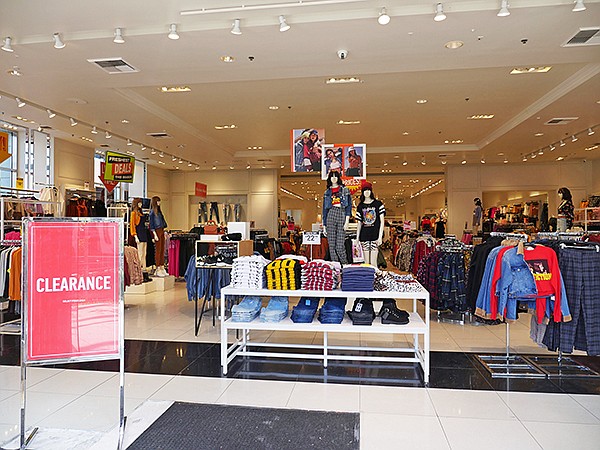RETAIL
After a Tough Summer, Forever 21 Seeks To Navigate Uncertain Future
It’s been a cruel summer for retail giant Forever 21. Just after Labor Day, lawyers for A-list celebrity Ariana Grande filed a suit against Forever 21 and its beauty brand, Riley Rose, in Los Angeles Federal District Court. The suit alleges the company used Grande’s image without her permission. Demanding $10 million in damages, the pop singer is suing for copyright and trade infringement.
This news was only the latest addition to a long list of issues that are taking a negative toll on the apparel company. In June, news broke that the Los Angeles–headquartered company had hired restructuring advisers to bolster its liquidity. Media reports also noted that the apparel company was in talks with private equity firm Apollo Global Management to raise debtor-in-possession funds for a possible chapter 11 bankruptcy filing. As of press time, Forever 21 has not filed for bankruptcy.
Just to make things seem tougher for Forever 21, the billionaire status of its founders Jin Sook and Do Won Chang has been slipping. They were taken off of Forbes Magazine’s list of the top 400 billionaires in 2018. The glossy business publication currently lists their combined worth as $1.5 billion, but in 2015 they were worth $5.9 billion, according to Forbes.
The lawsuit, anxiety over bankruptcy and a rankings slide of personal wealth were just the latest twists in a retail story that has commanded attention across the world. Forever 21 changed retail by being one of the savviest and most nimble players in fast fashion. In 2015, it ran 723 stores across the globe and claimed to be the fifth-largest specialty retailer in America. No matter what lies in store for the company, retail watchers forecast the company will have to change.
Forever 21 is definitely going to restructure, said Syama Meagher, chief executive officer of the Los Angeles–based Scaling Retail consultancy, who started her career by working in the merchandising offices of retailers Barneys New York and Macy’s.
“Forever 21 is overexposed in bricks-and-mortar,” Meagher said. “They’ll follow a Barneys model where they will shut down stores, streamline their options and get smarter about e-commerce.”
Meagher said that the once-innovative retailer allowed others to take over market share in digital commerce. This left Forever 21 open to reversals during a decade in which many brands have seen some of their most marked growth in digital commerce.
But a bankruptcy does not necessarily mean the end for Forever 21. Like other retailers that have experienced reversals, Forever 21 will have a second act. “A lot of second and third acts come through acquisitions,” Meagher said. “They have to define brand value. That could come through a face-lift for the brand and an acquisition of a younger and a cooler brand—something that is digitally native.”
Macy’s sought to reinvent itself by acquiring experiential retailer Story in 2018 and then rolling it out to a number of Macy’s locations.
In the 1990s and during the first decade of the 21st century, Forever 21 was known as one of the most innovative merchandisers in the business, said Ilse Metchek, president of the California Fashion Association manufacturers-and-retailers group as well as a veteran watcher of the fashion-business world.
“They were like what Zara is now. They sold small runs of new and fresh clothing. If you didn’t get them then, you were never going to get them. They were brilliant,” Metchek recalled of how Forever 21 built legions of fashion fans.
“When they found a nugget, they barreled in and put it in every store with as many iterations as they could,” she said. “They created their own trends.”
But Forever 21 stumbled when the brand started thinking big. One of the reasons the company may have lost its edge could be due to how it started opening giant emporiums across the world. Venturing into this undertaking meant that they had to fill a lot of space with a lot of inventory. The company ran against changing customer tastes, but it wasn’t alone.
Every retailer that ran stores with sprawling square footages was pummeled by a public who embraced a less-is-more attitude. “Every customer—male, female, young and old—is not absorbing huge amounts of merchandise,” Metchek said.
A Forever 21 restructuring process won’t have much impact on California’s manufacturing scene, Metchek said. For more than five years, Forever 21 has manufactured the vast majority of its product overseas.
Ken Wengrod, co-founder of FTC Commercial Corp, agreed that it won’t be the manufacturers in the United States who will suffer with a Forever 21 restructuring. “The biggest concern that I’ve seen is the impact on the real-estate market,” he said.
A restructuring for Forever 21 will probably mean that the retail giant will scale back its bricks-and-mortar retail fleet. The average Forever 21 retail store occupies 38,000 square feet, with the largest shop measuring 162,000 square feet, according to the retailer’s website. With Forever 21 shops doing business on retail streets as well as inside malls across the world, landlords might have a lot of open space coming up in the future.






















